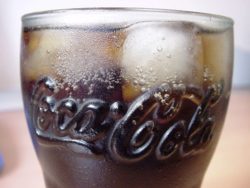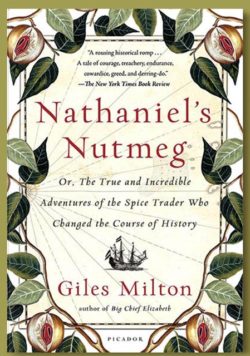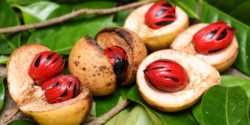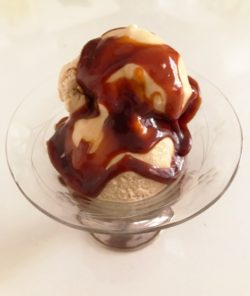Read Time: 4 Minutes Subscribe & Share
In A Nutshell
 Have you ever grated nutmeg into a recipe, then tossed out the few remaining chips without a second thought? We have all been there, done that. We pull out the nutmeg for holiday recipes or maybe to flavor a cream sauce without a thought to its spicy history. But did you know that every teaspoon of the stuff boasts a pedigree of folklore, medicinal cures, aphrodisiacs, hallucinogens, secret beverage recipes, trade wars, island domination, genocide, and a historic land trade?
Have you ever grated nutmeg into a recipe, then tossed out the few remaining chips without a second thought? We have all been there, done that. We pull out the nutmeg for holiday recipes or maybe to flavor a cream sauce without a thought to its spicy history. But did you know that every teaspoon of the stuff boasts a pedigree of folklore, medicinal cures, aphrodisiacs, hallucinogens, secret beverage recipes, trade wars, island domination, genocide, and a historic land trade?
This small nut, Myrsitica fragrans, means “fragrantly musky” and was used by ancient East Indians and the Chinese for medicine. Arab traders, who successfully flummoxed Europeans for years about the origins of the spices they traded, first brought it to Chaucer’s England in the 13th century. Over the centuries, people carried nutmeg to ward off evil, ensure good health, protect against the plague, enhance their sexual antics, and flavor punches and rums. In the 18th century, English gentlemen carried silver nutmeg graters in their waist coats along with their hip flasks, snuffboxes, and traveling 3-pronged forks. In the 19th century in England, perfumes featured nutmeg in their aroma profile, adding a spicy, musky smell to the wearer and winning the moniker, the sorcerer’s scent.
Is Nothing Sacred?
Nutmeg consumed in large quantities (up to 2 tablespoons of freshly grated) can indeed produce hallucinogenic effects, even though it does not cure The Plague. Nutmeg became the substitute  ingredient for cocaine in the manufacture of cola soda drinks when its usage was banned. Coca Cola and Pepsi today each buy more than 400,000 liters of nutmeg oil annually.
ingredient for cocaine in the manufacture of cola soda drinks when its usage was banned. Coca Cola and Pepsi today each buy more than 400,000 liters of nutmeg oil annually.
 The story of the nutmeg trade and how the English struggled with the Dutch to get into the lucrative East Indian nutmeg trade in the 1600’s is chronicled in English author, Giles Milton’s Nathaniel’s Nutmeg: or, The True and Incredible Adventures of the Spice Trader Who Changed the Course of History. This true story recounts the brutal spice wars and the lust for power, trade, and domination of the indigenous people of the Indonesian Islands where nutmeg was produced in abundance. In this startling study about the pursuit of nutmeg, Milton brings into focus Nathaniel Courthope, the man who was pivotal in one of the greatest land swaps in history. Nutmeg made rich English and Dutch men richer and decimated the natives of the Indonesian islands. In fact, it was the Dutch who created the foundation of capitalism (and some would say literally Cutthroat Capitalism) in order to crack the spice trade stranglehold of the Portuguese, particularly for nutmeg. At the height of the trade wars, nutmeg was resold at a 60,000% mark-up, and one pound was worth seven fat oxen.
The story of the nutmeg trade and how the English struggled with the Dutch to get into the lucrative East Indian nutmeg trade in the 1600’s is chronicled in English author, Giles Milton’s Nathaniel’s Nutmeg: or, The True and Incredible Adventures of the Spice Trader Who Changed the Course of History. This true story recounts the brutal spice wars and the lust for power, trade, and domination of the indigenous people of the Indonesian Islands where nutmeg was produced in abundance. In this startling study about the pursuit of nutmeg, Milton brings into focus Nathaniel Courthope, the man who was pivotal in one of the greatest land swaps in history. Nutmeg made rich English and Dutch men richer and decimated the natives of the Indonesian islands. In fact, it was the Dutch who created the foundation of capitalism (and some would say literally Cutthroat Capitalism) in order to crack the spice trade stranglehold of the Portuguese, particularly for nutmeg. At the height of the trade wars, nutmeg was resold at a 60,000% mark-up, and one pound was worth seven fat oxen.
The United States, especially New York, owes a special debt of gratitude to this little nut. To end the standoff and the bloodshed between the Dutch and the English, the 1667 Treaty of Breda settled the exhausting and long-running conflict over ownership of the spice islands. It gave the British-controlled and rich nutmeg-covered Isle of Run to the Dutch and awarded the “valueless land on the other side of the new world” known as New Amsterdam, to the British, who promptly renamed it New York. And now, Run, which was marked on every maritime navigation map for centuries, is no longer cartographically acknowledged.
The English had the last laugh. In addition to getting what is now New York, before they left the Isle of Run and the Moluccas, they uprooted many of the plants and transported them to their colony, Sri Lanka… thus ending the monopoly on nutmeg.
Nutmeg or Mace?
Both are part of the same fruit: Mace is the vein-like threads that cover the dried fruit; nutmeg is the kernel inside the seed. Mace is spicier and has more kick like cinnamon and pepper. Nutmeg is warmer, nuttier, gentler in recipes. In a pinch, you can interchange them, but just watch the amount of mace used to substitute for nutmeg. It gives a subtle flavor to a cheese souffles, quiches and gnocchi. And it is the secret to some Bolognese ragù recipes. To paraphrase an article from Serious Eats, of mace, Max Falkowitz writes:
more kick like cinnamon and pepper. Nutmeg is warmer, nuttier, gentler in recipes. In a pinch, you can interchange them, but just watch the amount of mace used to substitute for nutmeg. It gives a subtle flavor to a cheese souffles, quiches and gnocchi. And it is the secret to some Bolognese ragù recipes. To paraphrase an article from Serious Eats, of mace, Max Falkowitz writes:
 “Imagine a cross between nutmeg and coriander, tinged with citrus and cinnamon. Add to that the same nostril-widening properties that nutmeg, mint, and basil share. Then add the complexity of raw sugar. That’s mace”
“Imagine a cross between nutmeg and coriander, tinged with citrus and cinnamon. Add to that the same nostril-widening properties that nutmeg, mint, and basil share. Then add the complexity of raw sugar. That’s mace”
On their advice, Nancy has used it in peach and raspberry desserts and mace hits the right notes. Nutmeg is a deeper flavor while mace is a bit more of a topnote. The recipe below for Nutmeg ice cream she adapted from the 1991 Gourmet Cookbook. As it is time to make Stephanie’s Pumpkin Cookies, this is the perfect accessory.


- 1 1/2 cups (355ml) whole milk
- 1 1/2 cups (355ml) heavy cream
- 3 large eggs
- 3/4 cup (150gr) light muscovado sugar
- 2 tsp freshly grated nutmeg - more or less to your taste
- 1/8 tsp fine sea salt
- 1/4 tsp vanilla paste or essence
- In a sauce pan combine the milk, cream, and half the sugar.with the amount of grated nutmeg that suits your taste -
- In a mixer bowl, combine the eggs with the other half of the sugar, salt, and vanilla.
- While you put the mixer on medium speed and whisk the egg mixture until it is creamy, bring the milk mixture up to a full boil, then remove from the heat.
- Add a bit of the hot milk and cream to the egg mixture, whisking, and then add the rest, whisking constantly.
- Check your temperature. You should be over 175F when the two are combined, and then add vanilla.
- You can strain the mixture (optional) into a container, cover it and refrigerate until it is completely cold.
- Freeze in an ice cream maker.
- Stephanie Gorenflo taught me this method of making ice cream, and I have never gone back to any other.
- You can add more nutmeg at the end to bring it up to your taste.
- I made the mistake of adding liqueur to this ice cream one time - it just takes away from the nutmeg flavor rather than enhancing it.

Liz DiGregorio, newest Cuisinette, retired from a career in emergency management. She bought Julia Child’s Mastering the Art of French Cooking in 1967 and has been cooking ever since. Her love of Italian food is rooted in her DNA. When not re-arranging her cookbook library, she can be found in the garden, English mystery in hand and plotting her next escape from DC.




Speaking of essence, do you have a source for those wonderful fruit essences you sold in the store? I am especially fond of peach and fraise du boise.
Hi Janet,
I have been working with Simplygourmand.com as a supplier for these essence. There will be a Juicy Post on this in December. They have three essences so far: coconut, lemon and vanilla
Nancy
Confused about addition of nutmeg and vanilla. I’m guessing nutmeg goes into the egg mixture (not vanilla) and the vanilla is added at the end as described? Please clarify. Thanks!
Hi Maura,
Thanks for catching that. The nutmeg goes into the cream mixture that is on the stove and then the vanilla goes into the final mixture before you cool the ice cream for final prep in your ice cream freeze.
Nancy
I love Stephanie’s “miracle” techniques for ice cream AS IT REALLY WORKS EVERY TIME. This sounds like a good dessert to add to my Thanksgiving table. By the way, how does one become a Cuisinette?
In the text, you mention cheese souffles. If you click on that, it takes you to the recipe for the cheese and the chocolate souffles. However, the “PRINT” option for both recipes is disabled.